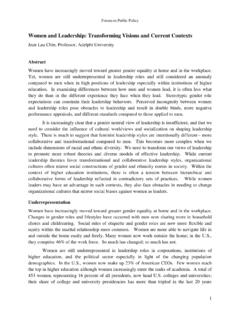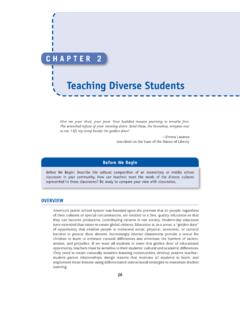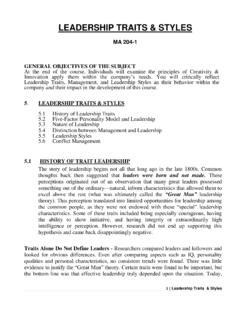Transcription of Leadership: Past, Present, and Future - SAGE Publications Inc
1 3In industrial, educational, and military settings, and in social movements, leadership plays a critical, if not the most critical, role, and is therefore an important subject for study and research.(Bass, 2008, p. 25) leadership matters, according to prominent leadership scholars (see also Bennis, 2007). But what is leadership ? That turns out to be a challenging question to answer. leadership is a complex and diverse topic, and trying to make sense of leadership research can be an intimidating endeavor. One com-prehensive handbook of leadership (Bass, 2008), covering more than a cen-tury of scientific study, comprises more than 1,200 pages of text and more than 200 additional pages of references! There is clearly a substantial schol-arly body of leadership theory and research that continues to grow each the sheer volume of leadership scholarship that is available, our purpose is not to try to review it all.
2 That is why our focus is on the nature or essence of leadership as we and our chapter authors see it. But to fully understand and appreciate the nature of leadership , it is essential that readers have some background knowledge of the history of leadership research, the various theoretical streams that have evolved over the years, and emerging issues that are pushing the boundaries of the leadership complicating our task is that more than one hundred years of leadership research have led to several paradigm shifts and a voluminous body of knowledge. On several occasions, scholars of leadership became quite frustrated by the large amount of false starts, incremental theoretical advances, and contradictory findings. As stated more than five decades ago by Warren Bennis (1959, pp. 259 260), Of all the hazy and confounding areas in social psychology, leadership theory undoubtedly contends for leadership : Past, Present, and FutureDavid V.
3 DayJohn Antonakis14 PART I INTRODUCTIONtop nomination.. Probably more has been written and less is known about leadership than about any other topic in the behavioral sciences. In a similar vein, Richard Hackman and Ruth Wageman (2007) more recently concluded that the leadership field is curiously unformed (p. 43).For those who are not aware of the various crises leadership researchers have faced, imagine taking pieces of several sets of jigsaw puzzles, mixing them, and then asking someone to put the pieces together into one cohesive picture. Analogously, leadership researchers have struggled for most of the last century to put together an integrated, theoretically cohesive view of the nature of leadership , invariably leading to disappointment in those who attempted it. Also, the puzzle itself is changing. As noted recently, leadership is an evolving construct that reflects ongoing changes in the challenges that require leader-ship (Day, in press).
4 For all these reasons, there has been much dissatisfaction and pessimism in the leadership field ( , Greene, 1977; Schriesheim & Kerr, 1977) and even calls for a moratorium on leadership research (Miner, 1975).Fortunately, a clearer picture is beginning to emerge. leadership scholars have been re-energized by new directions in the field, and research efforts have revitalized areas previously abandoned for apparent lack of consistency in findings ( , leadership trait theory). Our accumulated knowledge now allows us to explain the nature (including the biological bases) of leadership , its antecedents, and consequences with some degree of confidence. This accu-mulated knowledge is reflected in our volume, which will provide readers with a thorough overview of leadership and its complexities, advanced meth-ods used to study it, how it is assessed and developed, and evolutionary perspectives on the topic (see Part II).
5 We include six major theoretical per-spectives for studying leadership : individual differences , contingency, transfor-mational and charismatic, relational, follower-centric, and shared (see Part III). We also focus on leadership and special domains such as culture, gender , identity, and ethics (see Part IV).To provide the necessary background to understand the chapters that fol-low, we first acquaint readers with the concept of leadership and why leader-ship is necessary. Then we briefly trace the history of leadership research and examine its major schools, most of which are reviewed in our book. Our historical overview is also necessary as an organizing framework because chapter authors frequently refer to elements of the history of leadership research. We also discuss emerging issues in leadership research and how findings are being consolidated. Finally, we provide an overview of the book and a summary of each of the respective Is leadership ?
6 _____Leadership is one of social science s most examined phenomena. The scru-tiny afforded to leadership is not surprising, given that it is a universal activ-ity evident in humankind and in animal species (Bass, 2008). Reference to leadership is apparent throughout classical Western and Eastern writings Chapter 1 leadership : Past, Present, and Future 5with a widespread belief that leadership is vital for effective organizational and societal functioning. Nonetheless, leadership is often easy to identify in practice but it is difficult to define precisely. Given the complex nature of leadership , a specific and widely accepted definition of leadership does not exist and might never be found. Fred Fiedler (1971), for example, noted: There are almost as many definitions of leadership as there are leadership theories and there are almost as many theories of leadership as there are psychologists working in the field (p.)
7 1). Even in this absence of universal agreement, a broad definition of leadership is required before introducing the construct as a domain of scholarly leadership scholars would likely agree, at least in principle, that leadership can be defined in terms of (a) an influencing process and its resultant outcomes that occurs between a leader and followers and (b) how this influencing process is explained by the leader s dispositional characteris-tics and behaviors, follower perceptions and attributions of the leader, and the context in which the influencing process occurs. We recognize that this is a multifaceted definition that is heavily leader centric in describing mainly one-way effects associated with the personal characteristics of a leader; how-ever, it also includes aspects of the interaction between leader and follower (in terms of perceptions and attributions) as well as a definition of leadership as an effect with regard to the resulting outcomes ( , goal achievement).
8 We also acknowledge that leadership is rooted in a context, which may affect the type of leadership that emerges and whether it will be effective (Liden & Antonakis, 2009). Our broad definition of leadership thus incorporates the most commonly used definitional features: the leader as person (dispositional characteristics), leader behavior, the effects of a leader, the interaction process between a leader and follower(s), and the importance of context (Bass, 2008).In setting forth any definition of leadership , it is also important that we differentiate it conceptually from power and management, respectively, because these concepts are often confused with leadership . Power refers to the means leaders have to potentially influence others. Examples include referent power ( , followers identification with the leader), expertise, the ability to reward or punish performance, and the formal power that is accorded legiti-mately based on one s role (Etzioni, 1964; French & Raven, 1968).
9 Thus, the ability to lead others requires that one has its distinction from management, leadership as seen from the New perspective (Bryman, 1992) is purpose-driven action that brings about change or transformation based on values, ideals, vision, symbols, and emotional exchanges. Management is objectives driven, resulting in stability grounded in rationality, bureaucratic means, and the fulfillment of contractual obligations ( , transactions). Although some view leaders and managers as different sorts of individuals (Zaleznik, 1992), others argue that successful leadership also requires successful management, that leader-ship and management are complementary, but that leadership goes beyond management, and that leadership is necessary for outcomes that exceed expectations (Bass, 1985, 1998; Bass & Riggio, 2006).6 PART I INTRODUCTIONAt its essence, leadership is functional and necessary for a variety of rea-sons.
10 On a supervisory level, leadership is required to complement organiza-tional systems (Katz & Kahn, 1978), establish and recognize group goals and values, recognize and integrate various individual styles and personalities in a group, maximize the use of group members abilities, and help resolve problems and conflicts in a group (Schutz, 1961, as cited in Bass, 2008). Thus, from a functional perspective, a leader is a completer who does or gets done whatever is not being adequately handled by a group (McGrath, 1962). At the strategic level, leadership is necessary to ensure the coordinated functioning of the organization as it interacts with a dynamic external envi-ronment (Katz & Kahn, 1978). That is, the organization must adapt to its context; for this to occur, its leaders must monitor the external and internal environments, formulate a strategy based on the strengths and weakness of the organizations and the opportunities presented by the environment, and monitor outcomes so that its strategic goals are met (Antonakis, House, Rowold, & Borgmann, 2010).














